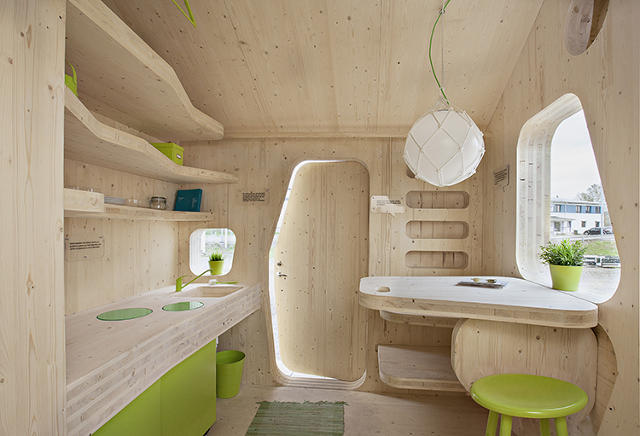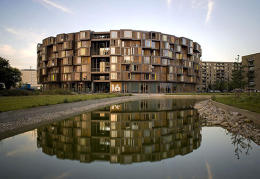School Leadership 2.0
A Network Connecting School Leaders From Around The Globe
These Tiny Wooden Houses Are The College Dorm Of The Future
These Tiny Wooden Houses Are The College Dorm Of The Future
Housing is expensive. So why not have students live in cubes they can afford? That's the idea behind the “smart student unit."
Fast Company
A few years ago, Swedish student housing company AF Bostäder had a young woman from the city of Lund inside live in a tiny house-box--not even 10 square meters large--to test the idea of a cheap, cheerful, and environmentally friendly “smart student unit" that included a toilet, kitchen, and bed. “I think she still lives there,” says Linda Camara ofTengbom Architects, the company behind the 2013 iteration of the living pod--a petite vision in pale wood offset with lime green plant pots, cushions and stools.
The premise for the cube, which has been in the works since 2007, is reasonable enough: students live and die on cheap housing, but everyone needs a toilet. It’s taken six years to whittle the tiny houses down to the current cross-laminated wooden test model form. The large kitchen was squirreled away in the original blueprint, but Tengbom redesigned it as the prime area after student feedback. The current space-efficient design, complete with a patio and vaulted sleeping area, lowers standard rent rates by 50%--music to the ears of any economically bereft twentysomething.

Swedish housing regulations require student apartments to cover a minimum of 25 square meters, but Tengbom’s cubes, designed for students at the University of Lund, are the first known exception. “We have a huge lack of student units in Sweden,” says Camara. “Social sustainability is to get more cost-efficient buildings fast and with high quality.”
The units are built with locally sourced wood. The small surface area of each unit, combined with minimal transportation costs for local renewable construction materials, drives down the units’ carbon footprint. And students won’t be freezing their socks off. “To endure the Swedish winter, we need to insulate them,” says Camara. “Cross laminated wood is enough for other types of houses or in warmer climate, and the final version must last for 100 years at least.” Each cube arrives on site as an Ikea-style flat pack--the test model took less than a week to put together.
 What if instead of a tiny wooden house, you lived in this amazing sustainable dorm in Denmark where every room ...?
What if instead of a tiny wooden house, you lived in this amazing sustainable dorm in Denmark where every room ...?Camara and the team at Tengbom will roll out a mini village in 2014, with an initial test run of 22 units arranged in blocks of eight. She’s thinking of ways to develop the project so tiny towns pop up on university campuses across Sweden, although Camara can’t promise that every unit will come with the swish green hammock hanging from the kitchen’s pseudo-ceiling in the prototype. “The design you see here is like a concept car,” she says. “This is the dream version--and we will fight to make it real.”
The current smart student unit prototype is available for viewing until December 8 at The Virserum Museum in Sweden. For the Swedish students holding keys to the inaugural cube rollout, pooping, eating, and sleeping like a high-functioning hamster could be the new definition of the good life.
JOIN SL 2.0
SUBSCRIBE TO
SCHOOL LEADERSHIP 2.0
Feedspot named School Leadership 2.0 one of the "Top 25 Educational Leadership Blogs"
"School Leadership 2.0 is the premier virtual learning community for school leaders from around the globe."
---------------------------
Our community is a subscription-based paid service ($19.95/year or only $1.99 per month for a trial membership) that will provide school leaders with outstanding resources. Learn more about membership to this service by clicking one of our links below.
Click HERE to subscribe as an individual.
Click HERE to learn about group membership (i.e., association, leadership teams)
__________________
CREATE AN EMPLOYER PROFILE AND GET JOB ALERTS AT
SCHOOLLEADERSHIPJOBS.COM
New Partnership
Mentors.net - a Professional Development Resource
Mentors.net was founded in 1995 as a professional development resource for school administrators leading new teacher induction programs. It soon evolved into a destination where both new and student teachers could reflect on their teaching experiences. Now, nearly thirty years later, Mentors.net has taken on a new direction—serving as a platform for beginning teachers, preservice educators, and
other professionals to share their insights and experiences from the early years of teaching, with a focus on integrating artificial intelligence. We invite you to contribute by sharing your experiences in the form of a journal article, story, reflection, or timely tips, especially on how you incorporate AI into your teaching
practice. Submissions may range from a 500-word personal reflection to a 2,000-word article with formal citations.

You need to be a member of School Leadership 2.0 to add comments!
Join School Leadership 2.0